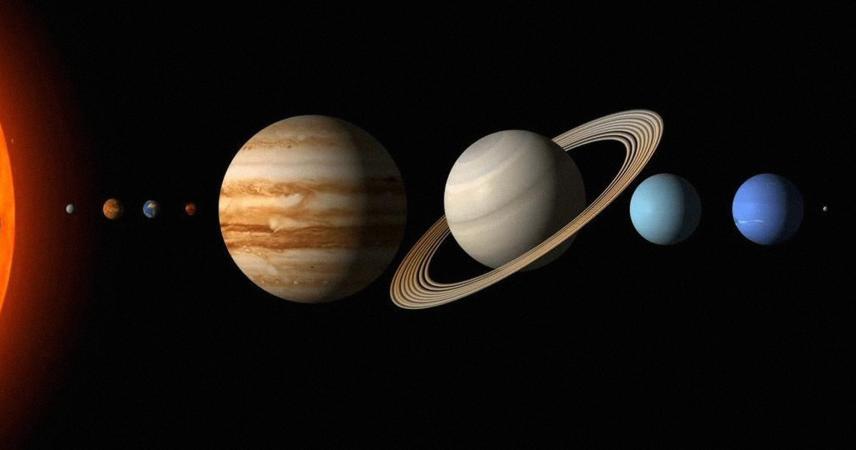The solar system is made up of eight planets. The four that are closest to the Sun are small and rocky, while those that are furthest away are enormous balls of gas.
On the dais you will find a scale representation of the main elements in the solar system. We encourage you to touch them and compare their relative sizes.
We start from the left with the planets closest to the Sun.
Mercury
Mercury is a planet that is slightly larger than the Moon and has hardly any atmosphere. On Mercury, the days are very long and the years very short, so 3 days on Mercury are equivalent to 2 years on Earth.
Venus
Venus is similar in size to the Earth, but its atmosphere is so dense and rich in Carbon Dioxide, that it causes a runaway greenhouse effect that raises its temperature up to 462º Celsius, which turns it into a furnace, and it is the hottest planet in the solar system.
Earth
The Earth is the largest of the rocky planets and is geologically active, so that it continues to be in a state of constant transformation. Its average temperature of 15 degrees allows liquid water to exist on its surface. It has an atmosphere and an ozone layer that protects the Earth from ultraviolet rays and gamma rays.
Mars
Mars is the planet that has been most visited and explored due to its proximity and the fact that it has so many similarities to the Earth. It is thought that it may have had a dense atmosphere and a surface covered in oceans. Its characteristic red colour is due to the presence of iron oxide on its surface.
Asteroid belt
Between the orbits of Mars and Jupiter there are thousands of minor bodies or asteroids made up of rock and metal, which are known as a whole as the asteroid belt. They are remnants of the formation process of the solar system. The material in the belt represents about 4% of the Moon. One of the most massive objects in the belt is the dwarf planet, Ceres.
Jupiter
Jupiter is the largest planet in the solar system and is a gigantic ball of gas.
Its most striking feature is the great red spot, a huge long-lived anticyclone. It has at least 95 natural satellites, the best-known are the Galilean moons: Io, Europa, Callisto and Ganymede, which is the largest moon in the solar system.
Saturn
Saturn is similar in its size, composition and strong winds to Jupiter, but it is known for its famous rings, a thin disc made of chunks of ice, dust and small frozen rocks, that measure from a few millimetres to several metres. Saturn also has more than 140 moons, the largest of these is Titan, an orb slightly larger than Mercury that has an atmosphere and liquid methane on its surface.
Uranus
At an enormous distance we come across Uranus, one of the ice giants that takes 84 years to go round the Sun. One of its most unusual features is the large tilt on its rotational axis (98 degrees), which may have been caused by a collision with a planetoid.
Neptune
Neptune, the other ice giant, has an atmosphere rich in methane which provides it with its characteristic deep blue colour.
Its atmospheric activity is so intense that its winds can reach 2,100 km/h.
Kuiper Belt
Beyond Neptune there is another ring, made up of icy bodies and known as the Kuiper belt, where Pluto is located, which until 2006 was considered to be the ninth planet in the solar system. And together with this there are other dwarf planets: Haumea, Makemake and Eris.
Finally, take a look at the circle on the wall. It is one and a half metres in diameter and represents the size of the Sun to scale with the planets that we have just touched.
If you carry on towards the left, you will be able to appreciate the textures of the planets.
